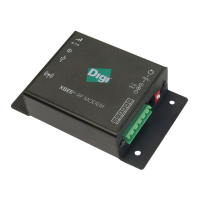XBee® Wi-Fi RF Modules
© 2013 Digi International, Inc. 39
XBee® Wi-Fi Standards
The XBee Wi-Fi module will operate in three of the available 802.11 standards.
802.11 b
The 802.11b standard was approved in July 1999 and can be considered the second
generation. 802.11b operates in the 2.4 GHz frequency ISM band. The data rate is from
1 to 11 Mbps.
802.11 g
The 802.11g standard was approved in 2003. It provides a maximum data rate of 54
Mbps. In addition, the standard is also fully backwards-compatible with existing 802.11b
wireless networks.
802.11 n
The 802.11n standard was approved in 2009. It provides for data rates up to 300Mbps.
The XBee® Wi-Fi module uses the single stream n mode with 20MHz bandwidth and is
capable of up to 72.2 Mbps over the air in n mode.
Encryption
Encryption is a method of scrambling a message that makes it unreadable to unwanted
parties, adding a degree of secure communications. There are different protocols for
providing encryption, and the XBee Wi-Fi module supports WPA, WPA2, and WEP.
Authentication
Authentication deals with proving the identity of the wireless device attempting to
associate with the network. There are different methods of doing this. The XBee Wi-Fi
module supports Open and Shared Key.
Open
Open Authentication is when the access point simply accepts the wireless devices
identity without verifying or proving it. The benefits to this is simplicity and
compatibility (all devices can do it).
Shared Key
Shared Key is when the wireless devices must present the proper key to get on the
network. Although Shared Key has more security than Open Authentication it should
not be considered secure. One of the benefits of Shared Key Authentication is simplicity.
Channels
The XBee® Wi-Fi modules operate in the 2412-2472 MHz range. The frequency range is
broken down into 13 channels. Data is transmitted on a channel by radio frequencies
over a certain frequency range. In order to avoid bad performance caused by the
overlapping (“collision”) of channel frequencies in a wireless LAN environment, it is very
important that the channels of neighboring access points are selected accordingly.

